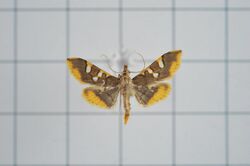Biology:Trichaeini
| Trichaeini | |
|---|---|

| |
| Prophantis adusta | |
| Scientific classification | |
| Domain: | Eukaryota |
| Kingdom: | Animalia |
| Phylum: | Arthropoda |
| Class: | Insecta |
| Order: | Lepidoptera |
| Family: | Crambidae |
| Subfamily: | Spilomelinae |
| Tribe: | Trichaeini Mally et al., 2019[1] |
Trichaeini is a tribe of the species-rich subfamily Spilomelinae in the pyraloid moth family Crambidae. The tribe was erected by Richard Mally, James E. Hayden, Christoph Neinhuis, Bjarte H. Jordal and Matthias Nuss in 2019.[1]
Description
Adult Trichaeini are characterised by a single synapomorphy in the male genitalia: a raised sclerotised ridge is present on the sacculus, running from the basal to the dorsodistal part. Further characteristics of Trichaeini are the weakly sclerotised, lens-shaped valvae, the strongly (in Trichaea and Archernis humilis) to weakly sclerotized fibula with simple hairs, and the scaly sacculus. In the female genitalia, the ductus bursae is broad, but narrowing at the posterior end, and the corpus bursae bears a slim longitudinal signum. In some Prophantis species, the anterior end of the signum is split into two anterolateral legs – a condition that is also found in Syngamia in the Nomophilini.[1]
Food plants
The caterpillars of Trichaeini primarily feed on plants of the Rubiaceae family. The coffee berry moths Prophantis longicornalis, P. octoguttalis and P. smaragdina are considered pests on Coffea arabica, the Arabian coffee. They are known to also feed on the Rubiaceae plants Bertiera zaluzania, Gardenia, Ixora coccinea and Tricalysia, the Verbenaceae Duranta plumieri, and Triclisia in the Menispermaceae.[2][3] Trichaea larvae feed on species of Psychotria, on Morinda panamensis and Margaritopsis microdon (all Rubiaceae), but were also recorded from Urticaceae and Celastraceae.[4] Recently, Archernis humilis was discovered to feed on the skunk vine Paederia foetida. It was investigated as a potential biological control agent against this invasive plant species in North America, but was found to not be hostplant-specific enough for this purpose, as the caterpillars also feed on the North American endemic Paederia ciliata.[5]
Distribution
The species of Archernis and Prophantis are distributed in the tropics and subtropics of Australia and the Old World, i.e., Africa and Asia. The species of the other three genera are found in the tropics and subtropics of the Americas.
Systematics
The tribe currently comprises 36 species in five genera:[6]
- Archernis Meyrick, 1886
- Prophantis Warren, 1896
- Sacculosia Amsel, 1956
- Trichaea Herrich-Schäffer, 1866 (synonyms Acridura Butler, 1875, Phryctena Oberthür, 1881)
- Zenamorpha Amsel, 1956
The larval feeding on Rubiaceae is shared with the tribe Nomophilini, which might be the sister group of Trichaeini.[1]
References
- ↑ 1.0 1.1 1.2 1.3 Mally, Richard; Hayden, James E.; Neinhuis, Christoph; Jordal, Bjarte H.; Nuss, Matthias (2019). "The phylogenetic systematics of Spilomelinae and Pyraustinae (Lepidoptera: Pyraloidea: Crambidae) inferred from DNA and morphology". Arthropod Systematics & Phylogeny 77 (1): 141–204. doi:10.26049/ASP77-1-2019-07. ISSN 1863-7221. http://www.senckenberg.de/files/content/forschung/publikationen/arthropodsystematics/asp_77_1/07_asp_77-1_mally_141-204.pdf.
- ↑ Waller, Jim M.; Bigger, M.; Hillocks, Rory J. (2007). Coffee Pests, Diseases and Their Management. Wallingford, UK: CAB International. pp. i–viii, 1–434. doi:10.1079/9781845931292.0000. ISBN 9781845931292.
- ↑ Guillermet, C. (2009) (in fr). Les Hétérocères, ou papillons de nuit, de l'île de La Réunion, Familles des Pyralidae et Crambidae. Association Nature, Découverte et Partage/Parc National de La Réunion. pp. 1–552.
- ↑ Janzen, Daniel H.; Hallwachs, Winifred (2009). "Dynamic database for an inventory of the macrocaterpillar fauna, and its food plants and parasitoids, of Area de Conservacion Guanacaste (ACG), northwestern Costa Rica". http://janzen.sas.upenn.edu.
- ↑ Solis, Maria Alma; Pratt, Paul D.; Mattison, Elizabeth; Makinson, Jeff; Purcell, Matthew; Raymaihi, Min B.; Mally, Richard (2020). "Archernis humilis (Swinhoe) (Lepidoptera: Crambidae) rediscovered feeding on skunk vine (Paederia foetida L.) in Southeast Asia". Proceedings of the Entomological Society of Washington 122 (3): 732–749. doi:10.4289/0013-8797.122.3.732.
- ↑ Nuss, Matthias; Landry, Bernard; Mally, Richard; Vegliante, Francesca; Tränkner, Andreas; Bauer, Franziska; Hayden, James; Segerer, Andreas et al. (2003–2020). "Global Information System on Pyraloidea (GlobIZ)". http://www.pyraloidea.org.
Wikidata ☰ Q85810679 entry
 |

